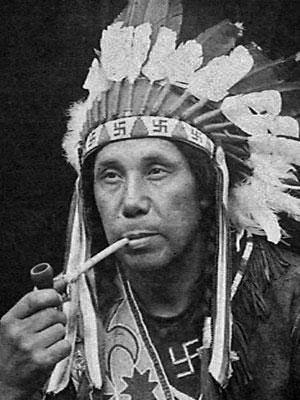|
|
Post by maxclint on Mar 28, 2015 20:42:47 GMT -5
reading through Joseph Agonitos book, "Lakota Portraits", I was surprised to see a photo titled "Rosebud Yellow Robe" . a young woman wearing a headband with a row of swastica style symbols. I have never seen this style before and wonder if this was common and was there any specific meaning to the design. I know that these type of symbols were used by several cultures {non indian}. but did not realize that the Lakota used them. hope someone can enliten me, thank you.
|
|
|
|
Post by nicolas (carlo) on Mar 29, 2015 1:48:18 GMT -5
Hi maxclint,
The swastika symbol is a well known symbol among the Hopi, and possibly among other tribes near them. It represents the Earth and Sun if I recall correctly, and has other religious connotations as well. However, to my knowledge, the swastika was/is not part of Lakota symbolism or associated with any of the plains tribes, so the headband may have come from one of the southern desert tribes, or a studio prop. The photo seems to have been taken in the late 1920s, when accuracy in portraying native americans wearing their own traditional clothes was not a big concern. (As can be seen on the wikipedia page for her, she was herself not too concerned with that either, as evidenced by the photo of her in a non-native garment, wearing a (gasp!) war bonnet.)
Carlo
|
|
|
|
Post by waganari on Mar 29, 2015 7:54:37 GMT -5
William Neptune, Indian tribe chief of Passamaquoddy, photo 1920.  Chief Wrinkled Meat Chief Wrinkled Meat (aka John Smith) of the Chippewa  |
|
|
|
Post by ladonna on Mar 29, 2015 10:01:29 GMT -5
it represents the four direction
|
|
|
|
Post by gregor on Mar 29, 2015 10:50:18 GMT -5
Here is more on Swastikas : en.wikipedia.org/wiki/SwastikaThe sign has been used over 3.000 years in different cultures. The earliest swastika known has been found in Mezine, Ukraine. It is carved on late paleolithic figurine of mammoth ivory. |
|
|
|
Post by maxclint on Mar 29, 2015 18:41:19 GMT -5
Thank you all for your replies. the photo was taken in 1927, so the headband was probably a prop. I did not think it was Lakota. thank you all again.
|
|
|
|
Post by rageofreason on Sept 15, 2015 15:30:44 GMT -5
Big Dipper swastika:  |
|
|
|
Post by maxclint on Sept 16, 2015 18:14:04 GMT -5
Thank you rageofreason, a very powerful image.I suppose with the history of this symbol and its affect on the history of mankind, a bigger picture has to be acknowledged.
|
|
|
|
Post by hreinn on Sept 18, 2015 15:44:07 GMT -5
rageofreason, this picture says more than 1000 words !
Very descriptive picture.
|
|
|
|
Post by windscythe on Sept 19, 2015 15:21:40 GMT -5
swastika is a union of square and circle
|
|